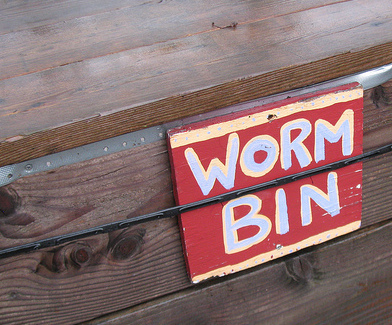
If you are living in a small NYC space, the idea of composting may seem impossible. While the city of New York has great resources for urban dwellers looking to compost (checkout the NYC Compost Project and compost pickup services like CompostNow), one of the best-kept urban composting secrets is worm bins. Yes, worm bins.
A worm bin is often small and fits perfectly inside apartments or on tiny balconies and patios. And, because it does not need to heat up like traditional backyard compost heaps, there is no foul odor—allowing you to compost all year-round without worry. According to Nature’s Footprint, the compost created by worms is incredibly nutrient-rich and can be used outside or inside the house.
So, how do you create your own worm bin? Here are the steps you need to take:
Get a Worm Bin
Worm bins can be purchased from numerous online vendors or from your local gardening supply store. In New York, contact the Lower East Side Ecology Center to inquire about their worm bin which includes 1 pound of red wiggler worms. If you don’t want to purchase a bin, you can make your own using a plastic storage container. Get directions here.
Find a Home for Your Bin
If keeping it outside, place it in a cool, dry area such as under a tree or awning. You want the temperature in the bin to stay between 55 and 80 degrees, which is why almost any indoor location will work.
Get Worms
There are more than 7,000 species of worms, but only one type that works best for composting: red wigglers. If worms do not come with your bin purchase (see above), you can buy them online or from a local retailer. Click here for a list of local NYC retailers. It is recommended you start with one pound of worms; they will process about three and half pounds of food scraps a week.
Prepare Your Bedding
Fill your bin about two-thirds full of moistened shredded newspaper (or thin strips of cardboard, dry grass, etc.) sprinkled with a handful of dirt. Gently sprinkle your worms on top—they will burrow down on their own.
Feed Your Worms
Feed your worms at least once a week using fruit and vegetable scraps, coffee grounds, tea leaves or egg shells. Avoid meat and dairy products or food scraps that have been cooked with oil. It is also suggested you avoid spicy or salty foods and large amounts of citrus.
Every time you feed your worms, evaluate the conditions of your bin—making sure it smells “earthy” like soil, has food scraps/bedding disappearing over time and is damp but not soggy. The NYC Compost Project has a great troubleshooting list for how to maintain your worm bin.
Talk to us: Are you an urban composter? How do you use your compost?
image courtesy of flickr CC/Eden, Janine and Jim
